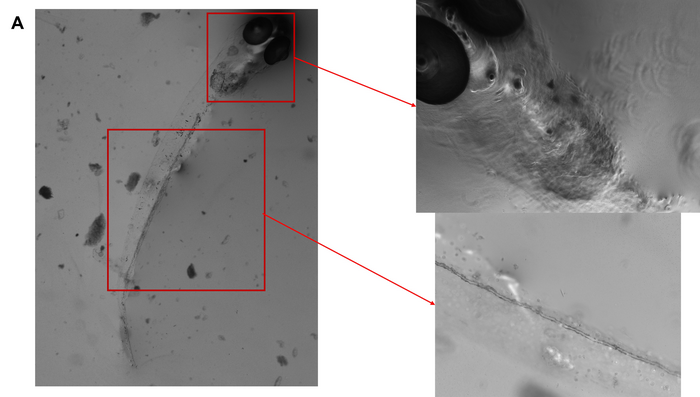CORVALLIS, Ore. – While microplastics have received significant attention in recent years for their negative environmental impacts, a new study from Oregon State University scientists found microfibers from synthetic materials as well as cotton impacted the behavior and growth of water organisms.

Credit: Oregon State University
CORVALLIS, Ore. – While microplastics have received significant attention in recent years for their negative environmental impacts, a new study from Oregon State University scientists found microfibers from synthetic materials as well as cotton impacted the behavior and growth of water organisms.
“We’re trying to shift the narrative a little bit because so much of the focus has been just on the plastics, but really we need to focus more generally on microfibers of all types,” said Susanne Brander, an associate professor and ecotoxicologist at Oregon State. “What we are seeing is that even the cotton, while it has less of an impact than the synthetic materials, still has an impact on the growth and behavior of the organisms we studied.”
The study, published this week in the journal Frontiers in Marine Science, is being released at a time of increased attention on regulating microfibers. Like microplastics, microfibers are of concern because scientists are increasingly identifying them in water samples and finding they are causing adverse impacts in organisms and ecosystems.
A bill was recently introduced in Oregon that would require new clothes washers sold in the state be equipped with a microfiber filtration system. France recently approved a similar measure and several other countries, states and provinces are considering bills. Related, a study from Canada in 2021 found that washing machine filters reduce microfiber emissions.
Brander, who studies the responses of aquatic organisms to environmental stressors, believes other measures could be taken to reduce the release of microfibers, including increasing the sustainability of clothing so that it sheds less and passing laws that would require filters on both clothes washers and dryers. Previous studies have found dryers are an underestimated source of microfibers being released into the environment.
“The answer isn’t to stop using cotton but to have a better awareness and better control over the release of fibers,” Brander said.
For the new study, Brander’s lab, with support from the lab of Stacey Harper, a professor of toxicology and environmental engineering at Oregon State, created microfiber samples of different sizes from ropes made of cotton, polyester and polypropylene, all of which are commonly found in coastal waters, including in wild organisms such as rockfish and zooplankton that Brander’s students study.
The researchers then exposed larval and juvenile inland silverside and mysid shrimp, both model organisms for estuaries and coastal ecosystems, to the three microfiber types at three concentrations and different levels of salinity meant to mimic conditions in an estuary and measured behavioral responses, growth and ingestion levels in the two organisms.
Among their findings:
- Cotton had no effect on growth in silversides but did reduce growth in the mysids at the two lower salinities. This finding surprised Brander, who thought the researchers would find growth impacts on both organisms or neither, not just one. She speculated that the finding may be a result of the silversides being better at breaking down the cotton than the shrimp.
- Synthetic fibers reduced growth in both organisms over just a few days of exposure.
- Polyester and polypropylene had more of an effect on behavior than cotton did in both organisms. Brander believes this could be due to residual chemicals on the polyester and polypropylene, which could remain despite the researchers rinsing the microfibers.
- Cotton was not detected in the digestive tracts of silversides, however polyester and polypropylene were detected in the silversides’ stomach and gut lining. None of the fiber types were detected in mysid shrimps.
- Cotton impacted both organisms’ behavior more at higher salinities, whereas polyester and polypropylene had more behavioral impacts at lower salinities. This could be due to differences in the densities of the different materials, which influences how long they stay in suspension.
“Increasing amounts of microfibers are being detected in environmental samples and we really need to identify the risk associated with them, especially at sensitive early life stages of organisms,” Harper said. “This study and others begin to do that, but more research is needed.”
The research is supported by a National Science Foundation Growing Convergence Research Big Idea grant. The grant supports the Oregon State-based Pacific Northwest Consortium of Plastics, which Harper and Brander co-lead.
Harper and Brander are based in the Oregon State College of Agricultural Sciences. Harper also has an appointment in the College of Engineering. This research was led by Samreen Siddiqui, a former postdoctoral fellow in Brander’s lab. Graduate students Sarah Hutton and John Dickens and technician Emily Pedersen also contributed.
Journal
Frontiers in Marine Science
DOI
10.3389/fmars.2022.991650
Article Title
Natural and synthetic microfibers alter growth and behavior in early life stages of estuarine organisms
Article Publication Date
31-Jan-2023




